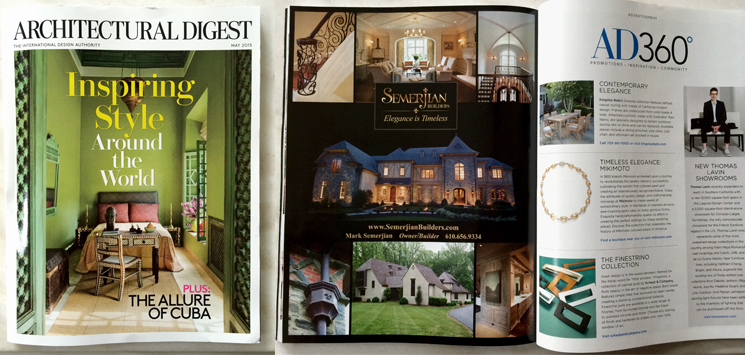Mark Semerjian featured for his advice on custom building and main line new construction.
“Though the real estate downturn pushed down the value of many an existing house, the cost of land has not fallen in the most popular areas of the Main Line and the western suburbs, where vacant buildable lots are scarce, said custom builder Mark Semerjian of Semerjian Builders, in Devon.”
Why houses in $300,000-$500,000 range are scarce:
read entire article here: http://articles.philly.com/2014-05-11/business/49773614_1_mark-semerjian-lumber-costs-philadelphia-region
By Alan J. Heavens, Inquirer Real Estate Writer
Posted: May 11, 2014
Realtor after Realtor bemoans this abiding fact about the Philadelphia region’s home-resale market: There are woefully few properties for sale in the $300,000-to-$500,000 range, which agents call “the sweet spot.”
Ranking high among the reasons for this is that during the housing boom, many potential sellers bought homes that would fit that range at much higher prices – and thus would lose money if they sold for what the market would bear today.
It’s a high demand/low supply quandary that would seem to leave the field wide open for new-home builders, whose sales have been lagging in recent months. But the builders aren’t rushing in – for a very fundamental reason.
“That’s an easy one: Land and development costs, because of excessive regulations, make building houses in that price range prohibitively expensive,” said David Della Porta, president of Cornerstone Communities, in Villanova.
Said Nelson “Chip” Vaughan of Vaughan & Sautter Builders, in Wayne: “The approval process, zoning, and infrastructure costs all add up to lots that are too big and too costly for homes to be sold in the $300,000 range.”
Though the real estate downturn pushed down the value of many an existing house, the cost of land has not fallen in the most popular areas of the Main Line and the western suburbs, where vacant buildable lots are scarce, said custom builder Mark Semerjian of Semerjian Builders, in Devon.
Many towns in those areas have implemented strict guidelines on storm-water management and runoff, Semerjian said, and the design and construction of the system required for each development add to the cost of each house.
Construction materials and labor costs, too, have been increasing, Semerjian said. For example, “cellular PVC [polyvinyl chloride] trim provides excellent durability [and] saves the need to replace and repaint every year,” he said. But it creates a larger up-front cost for builders because it’s more expensive to make – plus, manufacturers know its value and charge a premium for it.
Said Vaughan: “It is not hard to see why lower-cost housing in this part of the country gets further and further out of reach.”
Hanley Wood L.L.C., of Washington, which collects sale and price data nationwide, reported that the average price of a newly built home in the Philadelphia region was $424,623 in fourth quarter 2013 (the most recent data available), up 3.7 percent from 2012. Closings were down, and new-home sales comprised only 9.1 percent of this region’s market.
Housing economist Patrick Newport of IHS Global Insight, in Lexington, Mass., said higher costs, tight credit for builders, and too few developed lots to build on are holding construction down.
“For builders to ramp up . . . profit margins have to widen,” said Newport, noting that recent data show no change in those margins. “Lumber costs are way up, [and] I am hearing that fracking and tighter immigration policies are driving up wages in the construction sector.”
Yet most important, to Newport’s mind, is the relative absence of financing.
Developers “need credit before they can start work on a project,” said Newport, but “their lenders, mostly local banks, have not stepped up enough because many are still carrying on their books bad construction loans made during the boom years.”
“Banks with repaired balance sheets, burned once, may be reluctant to dish out new construction loans,” Newport said.
The first real hurdle, said South Jersey builder Brad Haber, “is that most builders I know are still building on ‘legacy lots’ that have a high-cost basis associated with them. They have to build a bigger house to justify the lot cost, but the financing and/or market isn’t there,” Haber said.
Voorhees-based builder Charles Kojeski has some of those “legacy lots.”
“I have been trying to deliver the under-$200,000 to $250,000 range, which is really difficult unless you can get the lot for free,” Kojeski said. If he could have a few $300,000 to $500,000 sales, “I could actually build on some of my lots in inventory that are too expensive to use on the $200,000-range homes.”
“Even if you have an infill lot for a first-time buyer, the permits cost $12,000,” he said.
South Jersey builder Bruce Paparone said he also sees new mortgage-lending requirements having an impact.
“FHA, which once was a place buyers could get qualified [for a mortgage] easier, is now more difficult than conventional financing in some cases, eliminating part of the market, along with other tightening requirements,” Paparone said.
Unless “a house is perfect,” said Scott Rote of Haven Homes, in Brigantine, N.J., “it is hard to get people qualified for a mortgage over $300,000.”
In addition, Rote said, there remains “a lot of short sales and foreclosures of big homes that can be bought cheap.”
A look at responses to the typical new-home buyer survey shows that people want houses packed with amenities.
John Westrum, who builds in Philadelphia and the suburbs as well as at the Shore, said that “it costs too much to build a product that consumers want” for $300,000.
Suburban builders, Westrum said, “are reluctant to embark on new large-scale communities for fear of a fragile economy and a tough lending environment, remembering the pain caused by the recent recession.”
It’s in the city where one sees “the largest increase in inventory” in that “sweet” price range, he said.
“Smaller builders are reusing existing city infrastructure to reduce costs, and thus keep the price down to $300,000 to $500,000,” Westrum said. “That same feat is harder in the outlying suburbs.”
aheavens@phillynews.com
215-854-2472 @alheavens
Philadelphia Inquirer – philly.com


